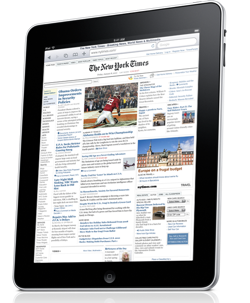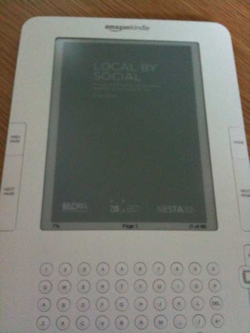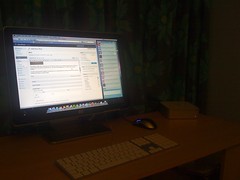 I’ve been playing with a new iPad recently – and I love it. The screen resolution on these things literally has to be seen to be believed.
I’ve been playing with a new iPad recently – and I love it. The screen resolution on these things literally has to be seen to be believed.
I had an original iPad before – the one without a camera – and it was also a wifi only one, without a mobile data plan. The result of this was that I rarely took it out of the house. My new one has a 3G connection, which means it’ll get online anywhere with a decent mobile signal.
This latter fact means I’m more likely to break Briggs’ Law – which states that it’s impossible to use a tablet computer in public without looking like a twerp.
Anyway, here’s my home screen with my most used apps. Let’s have a look at what I’ve been using, going through the rows from top to bottom and left to right.
WordPress – mainly for managing this blog, and if I’m honest for moderating comments and so on, rather than writing posts.
Calendar – I occasionally look at this, it seems to sync reasonably with my Google calendar.
Maps – handy for planning trips and so on.
Basecamp – not a native app but a web app whose bookmark I’ve saved to the home screen. Helps keep on track of projects.
Evernote – my favourite note keeping app which syncs nicely with the website and the app on my laptop.
Articles – a client for WikiPedia which seems to work quicker and formats more nicely than the website.
Remote – I can control my stereo in the lounge using this app.
WriteRoom – a lovely distraction free text editor. great for bashing in text, but if I’m honest I tend to just use Evernote.
Photos – for, you know, looking at photos.
RTM – Remember the Milk is a dead simple app for managing and syncing to do lists.
Camera – takes photos.
Draft – very simple app for drawing things with your finger, particularly outlines for website wireframes and so on.
iPlayer – it’s brilliant being able to watch BBC shows on this. It upsets me sometimes that my son doesn’t realise how magical it is!
iAnnotate PDF – I tried a few apps for annotating PDFs and this seems the best. Great for meetings – no printing required! I can type notes, highlight bits, scribble and doodle to my heart’s content.
Instapaper – if I see something online I want to read later, I can save it to Instapaper and pick it up later on, formatted beautifully for the iPad.
Mindnode – simple way of drawing mind maps.
Dropbox – the easiest way of getting documents to and from an iPad in my experience.
Reeder – my RSS reader of choice. Beautiful design and easy to use – and syncs with Google Reader.
OmniOutliner – I don’t tend to type too much on the iPad but I do like to plan documents using it, and an outliner is a great tool for that.
OmniFocus – the Rolls Royce of iPad todo list apps. Having played with it, it’s too much for me and RTM suits me better. To be replaced on my home screen by something new, soon, I’m sure!




